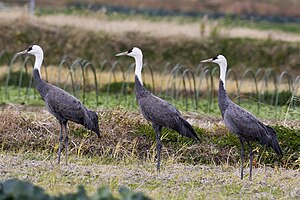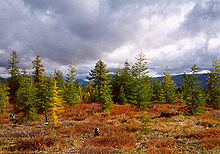Black crane
| Black crane | ||||||||||||
|---|---|---|---|---|---|---|---|---|---|---|---|---|

Black Cranes |
||||||||||||
| Systematics | ||||||||||||
|
||||||||||||
| Scientific name | ||||||||||||
| Grus monacha | ||||||||||||
| Temminck , 1835 |

The black crane ( Grus monacha ) is a small crane bird with dark gray plumage. The upper neck and head are white with the exception of a red, featherless spot on the top of the head. The crane species breeds in south-central and south-east Siberia and probably also in Mongolia . 80% of black cranes overwinter in Izumi and Shūnan . Further wintering areas are in South Korea and China .
The total population is estimated at 9500 animals. The IUCN classifies the black crane as endangered ( vulnerable ).
Appearance
Characteristics of adult black cranes
The black crane reaches a height of 100 to 115 centimeters. The wing span is 170 to 180 centimeters. It weighs an average of 2.5 kilograms. Females tend to stay a little smaller than males.
There is neither a conspicuous gender dimorphism nor a seasonal dimorphism . The body plumage and the wings are slate gray with a dark brown tinge on the top of the body. The sides of the head, the back of the head and the throat are white. The neck is also two-thirds white. The featherless part of the head is black. There is a red spot on the top of the head and on the back of the head. The eyes are dark yellow to orange-brown. The bill is horn yellow and darkens towards the tip. The legs are black.
Black cranes move extremely unobtrusively. Slow forward movement is typical, interrupted again and again by pausing and looking carefully at the surroundings. The legs are drawn up when walking and only slowly dipped back into the water. The bird's body is in a horizontal position when walking, and the head is tilted downward. Securing birds, on the other hand, raise their heads. Due to their well-developed eyesight, they can see people from a distance of 800 to 1000 meters. They then try to move away unnoticed by leaving or even fly up. Compared to the gray cranes that occur in summer from Central Europe to Central Asia , they are silent birds. Black cranes can, however, occasionally be heard together with their partner bird. These unison duets can be heard up to two kilometers away. The duets are an important part of the pairing process, but they can occasionally be heard as a territorial mark and sometimes even when the brood is separated. When calling, the two birds stand parallel to each other with their necks pointing upwards, while the male lifts the elbow part of the half-spread wings.
Occasionally there are hybrids between gray cranes and monk cranes . These are a little lighter than black cranes. Her neck is gray almost to her head.
Appearance of the young birds
The downy cubs are brown-yellow overall. A lighter back center line runs from the base of the neck to the rump. The shoulders are also a bit lighter and stand out from the rest of the dune dress. In the youth dress the fletching is dark gray with a dark brown tinge. The forehead, the sides of the head and the throat are light clay in color. The crown and the back of the head are red-yellow. The gray neck feathers have narrow, clay-colored hems.
Distribution area
The breeding area is closely linked to the larch taiga. The secured breeding areas include the central Siberian highlands in the catchment area of the upper reaches of the Wiljui and the Olekma-Tschara highlands. Other breeding areas are in the catchment area of the Bikin River in the Primorye district and in the lower Amur area . Black cranes that are obviously not yet sexually mature are occasionally found in the south of western and central Siberia and in southern Transbaikalia during the breeding season .
Black cranes migrate through the north of the Irkutsk district , through Buryatia and the south of the Chita district in autumn . From there they move via northeast Mongolia and Barga via Inner Mongolia to the Chinese province of Hebei . Another part of the population flies along the east side of the Großer Chignon over the middle Amur plain. From there they migrate over the Korean peninsula to the Japanese wintering areas. The islands of Honshū and Kyushu are important Japanese wintering areas . The population that overwinters near the town of Idsuma on Kyushu is particularly numerous. Their wintering areas there are under protection.
The monk cranes appear in their Japanese wintering areas from late October to early November. In the breeding areas in the Primorye area, they reappear at the beginning of April.
habitat
The breeding area of black cranes in the lowlands of the Bikin has been well studied. There the black crane breeds in Sphagnum-Moos-Hochmooren between mountain tops at altitudes between 200 and 600 meters. The undergrowth of this region consists of up to two meters high birch trees and other shrubs, including peat grate , porst , trunk berries and black-leaved willows . A large part consists of the small Dahurian larch . Cranberries , various narrow-leaved sedges , cotton grass , bitter clover and marsh horsetail are found on other low plants .
In the wintering areas in Japan, monk cranes spend the light of day at the feeding grounds. In the evening they return to the sleeping places about ten kilometers away. These are either on flooded rice fields or on open slopes of the surrounding mountains.
food
Black cranes feed mainly on plants. A large part of the diet is made up of berries, as well as sprouts and twigs of cotton grass and flowers and seeds of sedges. They also eat amphibians. In winter, the diet consists mainly of cereals.
Reproduction
Black cranes reach sexual maturity between three and four years of age. They are monogamous birds, the couple relationship is constant.
Black cranes arrive at their breeding grounds if there is still some snow there. Apparently the area is not being aggressively defended. Occasionally, two to three strange black cranes are seen together with the male looking for food not far from the nest while the female is breeding.
nest
The nest is not far from the edge of the open pot and is usually created in the middle of the sparse shrub vegetation. The stable nesting platform is built from plant material in the immediate vicinity of the nest location. Among other things, peat moss, roots and leaves of iris plants, reeds and various sedges are processed. Both parent birds are involved in building the nest. The full clutch consists of two eggs. These have a long-elliptical shape with a well-defined blunt and pointed pole. The basic tone is dark brown-gray with red-brown to dark brown spots of various shapes and sizes.
It mainly breeds the female. At the beginning of the brood it is detached from the male for 40 minutes to an hour in the morning and in the evening. This behavior changes a few days before the young hatch. From then on, both parent birds spend the same amount of time on the breeding business, with the male usually sitting on the nest during the day and the female at night.
Rearing the young birds
The boys hatch in the third decade of May. The hatching takes about 24 hours, the two young birds hatch every day. Your weight on the first day of life is between 85 and 93 grams. A nestling competition between the two young birds is not observed.
The first hatched young leaves the nest on the third day and is then looked after by the male. On the fourth day, the second cub joins, accompanied by the female. At the age of one week, the family group is already about two kilometers from the nest. Then they roam the entire breeding area. They remain in the area until around mid-August.
Duration
The population of black cranes is estimated to be around 11,600 sexually mature individuals. Although these use a very large breeding area, they overwinter in less than ten different regions that together only take up a small area. In most of these wintering areas, the number of birds observed has decreased. The IUCN expects this decline to continue.
The main threat to the species is the loss of suitable wintering sites in China and South Korea. The artificially high number of birds that overwinter in Izumi by supplementary feeding carries the risk that an epidemic or other catastrophe affecting this population will have a significant impact on the global population.
supporting documents
literature
- RL Potapov, VE Flint (HRSG): Handbook of Birds of the Soviet Union. Volume 4: Galliformes, Gruiformes. Aula Verlag, Wiesbaden 1989, ISBN 3-89104-417-8 .
Web links
- Grus monacha in the endangered Red List species the IUCN 2008. Posted by: BirdLife International, 2008. Accessed January 31 of 2009.
- Videos, photos and sound recordings of Grus monacha in the Internet Bird Collection

